Draw an Outer Electron Box Diagram for a Cation.
To write electron configurations and draw orbital box diagrams, there are 3 rules that must be applied.
one. The Aufbau Principle states that electrons are always placed in the everyman energy sublevel that is available.
ii. The Pauli Exclusion Principle states that each orbital may contain a maximum of two electrons; electrons must accept contrary spins.
iii. Hund's Dominion specifies that when orbitals of equal energy are available, the everyman energy electron configuration has the maximum number of unpaired electrons with parallel spins. In other words, the orbitals in a subshell must be half filled earlier pairing electrons.
The lowest energy orbitals must be filled outset. For case the 1s orbital is filled and so we can fill the 2s orbital and go along to the 2p orbitals. The filling order follows:
1s→2s→2p→3s→3p→4s→3d→4p→5s→4d→5p→6s→4f→5d→6p→7s→5f→6d→7p
Electron configurations and orbital box diagrams can be written right from the periodic table.
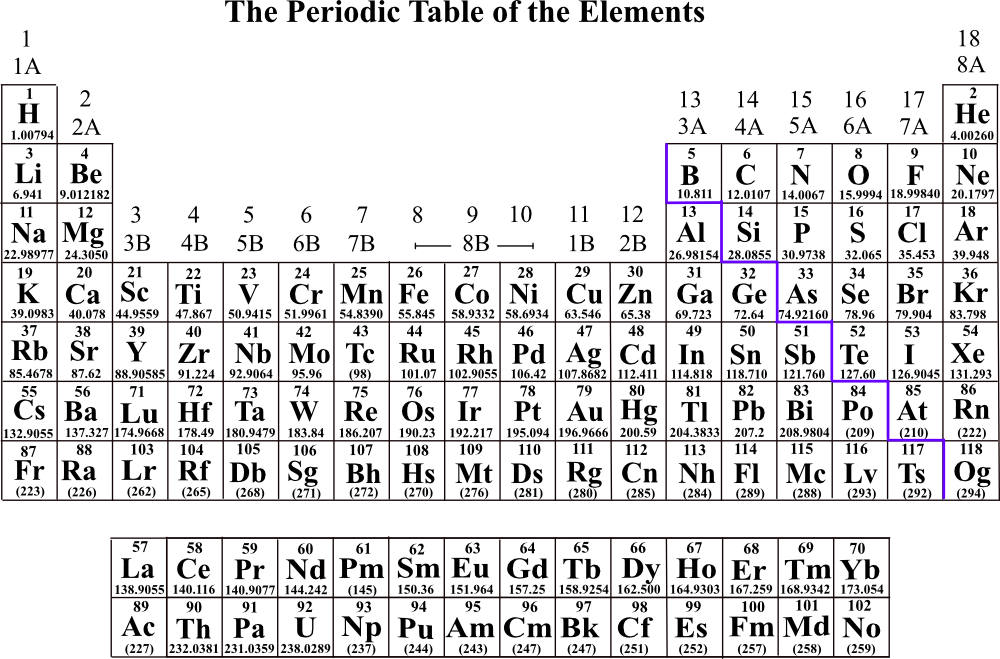
The periodic tabular array below, shows the south, p, d, and f-blocks. When reading the periodic table from left to right, one tin hands write an electron configuration without memorizing the filling lodge. You lot only need to know where the blocks are located on the periodic tabular array.
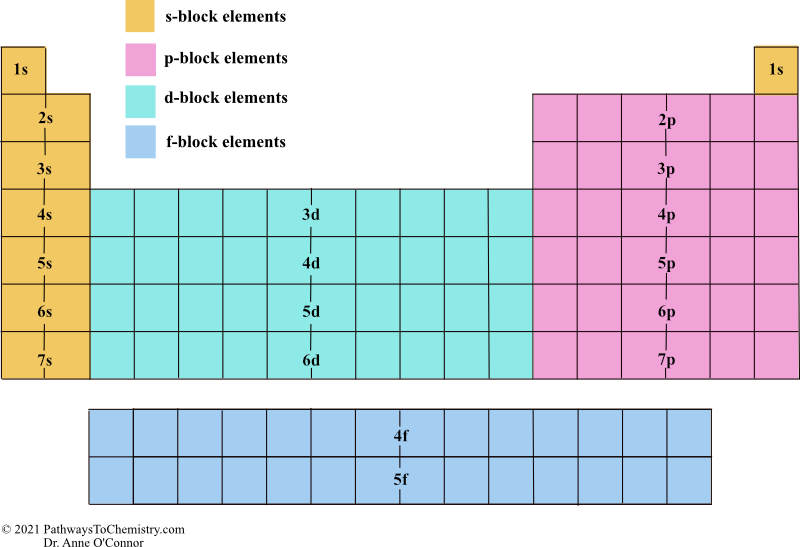
Hydrogen has one electron which goes into the 1s subshell. The electron configuration is 1s1 . Helium has two electrons and both electrons get into the 1s orbital and the electron configuration is 1s2 . Adjacent we go to lithium with 3 electrons; two of the electrons go into the 1s orbital and the third electron into the 2s orbital giving an electron configuration of 1s22sone . The iv electrons of Be get into the 1s and the 2s orbitals giving the electron configuration of 1s22stwo . Reading the periodic table from left to right, the boron atom has 5 electrons, and the electron configuration is 1s22stwo2pi . The electron configuration for carbon is 1s22stwo2p2 . An orbital box diagram can be written as well. Boxes, or horizontal lines represent the orbitals, arrows represent the electrons, and if an orbital is full, the electrons must exist of reverse spin–one arrow pointing upwardly and the other one pointing downwardly. The orbital box diagrams are listed for the start 20 elements in the figure beneath.
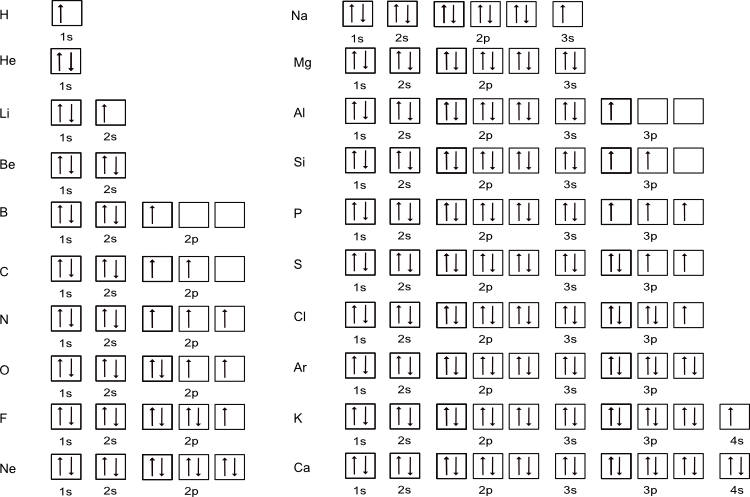
In the effigy beneath are the electron configurations for the first 20 elements.
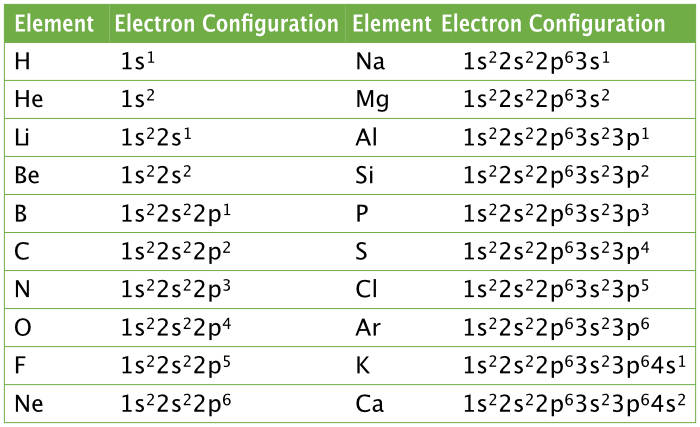
Adjacent, nosotros write the electron configuration for Sc. When reading the periodic table from left to correct we fill all the way to the 4s orbital and so fill a 3d orbital with the last electron. The electron configuration is 1s22stwo2p63s23p64s23d1. The electron configuration for Fe is 1s22s22pvi3sii3p64s23dvi. The electron configuration for Sn is 1s22s22pvi3sii3phalf dozen4sii3d104p65s24dten5p2.
Recall when we make full the 6s orbital, the next orbitals to exist filled are the 4f orbitals. The electron configuration for Lead is 1s22s22p63s23p64s23d104phalf-dozen5s24d105phalf-dozen6stwo4f145d106p2. Note, when the 4f orbitals were filled, we then fill up the 5d orbitals and the remaining electrons get into the 6p orbitals.
The outermost shell is the valence shell . The electrons in the valence shell are the valence electrons . For the main grouping elements, the number of valence shell electrons are equal to the group number (Groups 1A to 8A). For transition elements, the ns and the (n – 1)d electrons are the valence crush electrons. Sodium, in Grouping 1A, has 1 valence electron in the 3s oribital and chlorine in Group 7A has vii valence electrons, with 2 electrons in the 3s and 5 electrons in the 3p orbitals. Iron has 8 valence electrons with two electrons in the 4s subshell and 6 electrons in the 3d subshell. The valence electron configurations for all of the elements are in the periodic table below.
There is a shorthand way of writing electron configurations. For example, the electron configuration for sulfur is 1stwo2s22psix3s23p4. Up to the 2sp electrons is the noble gas configuration of neon. We can write the configuration as [Ne]3s23piv. The element of group 0 that comes before the sulfur atom, Ne, is placed in brackets and the rest of the configuration is written. The autograph electron configuration for Fe is [Ar]4s23d6. The configuration for Pb can be written as [Xe]6s24f145d106p2.
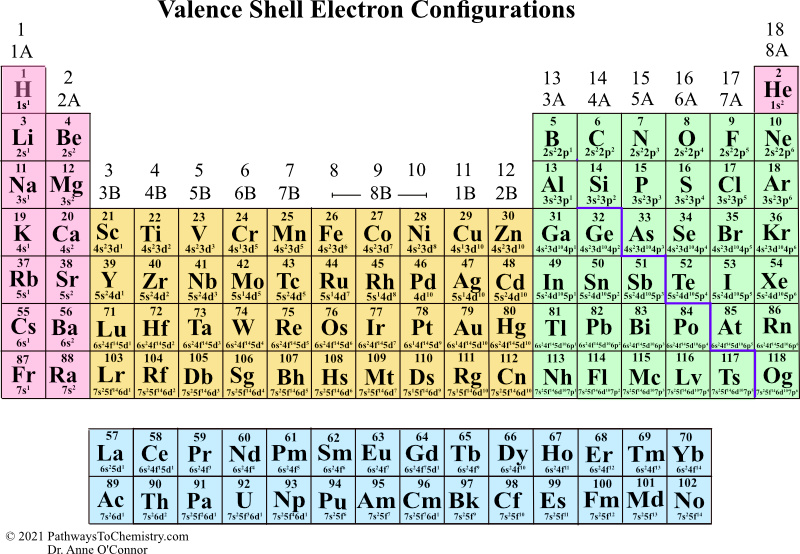
Anomalous Electron Configurations
In that location are over 20 elements that practise not follow the edifice up principle. For example, using the edifice up principle Cr would have an electron configuration of [Ar]4stwo3d4. Experiments show this is incorrect and the electron configuration for Cr is [Ar]4s13d5. It is more stable to motility the electron from the 4s orbital to the 3d orbital and have two one-half filled subshells. The aforementioned goes for Cu. The electron configuration is [Ar]4sone3d10. Information technology is more stable to move the electron from the 4s orbital into the 3d orbital and have a completely filled d subshell. The aforementioned is seen for Mo and Ag. As we move down the periodic table we run across in that location are more than dissonant electron configurations as shown in the periodic tabular array above.
Lookout man the post-obit videos before attempting exercises
mccallmuctlandly98.blogspot.com
Source: http://www.pathwaystochemistry.com/chemistry-qa/study-guide-general-chemistry-1/electronic-structure-of-atoms/electron-configurations-and-orbital-box-diagrams/

0 Response to "Draw an Outer Electron Box Diagram for a Cation."
Post a Comment